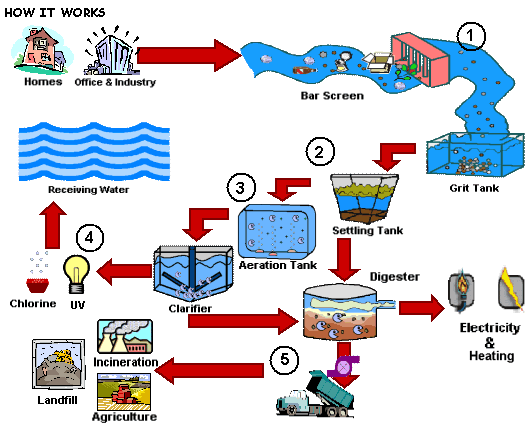Unknown Facts About Residential Water Treatment System
Table of ContentsAbout Residential Water Treatment SystemWhat Does Residential Water Treatment System Do?The Residential Water Treatment System PDFsSome Of Residential Water Treatment System

on the other hand, comes from production, industrial and also business tasks lugged as well as has a completely different composition than sewage water. How does it function? The initial step in this water treatment plant is that the wastewater drains pipes to the plant with the aid of gravity via the primary sewer system.
In this phase, the water relocates through the crushed rock chamber to remove any kind of grit. The water after that relocates to the bar screens which remove huge items.
This is then eliminated from the storage tank as well as disposed of at the dump. Next comes the sedimentation phase, additionally referred to as the primary therapy. In this stage, the water flows to the primary settling containers, also called pre-settling containers. These tanks have hoppers which are positioned in the base of the container where water streams with.
The Best Strategy To Use For Residential Water Treatment System
These clearing up tanks make it possible for the sludge to resolve and also then relocates to food digestion containers. In the food digestion tanks, the sludge is warmed as well as blended. Another vital point that occurs here is the production of biogas, which the wastewater treatment plants can reuse, in the production of electric or thermal power which is one more big advantage to the setting.

The last step in wastewater treatment is examination. This examination includes checking the contamination degree of the water treated and making certain it abides by the greatest requirements in order to be released or reused for domestic or commercial functions. residential water treatment system. Applications: Many petroleum refineries or petrochemical as well as chemical industries produce a large amount of wastewater as well as need on-site wastewater treatment plants.
The wastewater right here streams via displays and into settlement basins that can secure debris in large quantities. It functions as a pre-treatment as mentioned over as it occurs prior to 3 more aggressive stages- primary, additional and also tertiary treatment. Main Therapy During this stage, the wastewater moves into the clarifiers.
Our Residential Water Treatment System Ideas
It is the design of these containers that lead to clearing up, that is, the organic solid matter accumulates at the base of the tank while the lighter issue floats to the leading ending up being simpler for removal. The natural matter that resolves near the bottom is called a primary sludge covering.
Additional Treatment This therapy phase includes aerobic aeration. Oygenation containers consist of aerators, these have a system of pipelines or tubes connected to them. They are made of ceramic or rubber membranes that have small openings in them for air to pass through. When this air flows via the aerators, the tiny holes present, transform them into bubbles as well as they obtain combined with the water column.
This RAS goes back into the primary information storage tank and also the microorganisms in it aids in breaking down any type of natural issue in the sewage. Once RAS has actually entirely experienced both the key and also additional explanation basins continually, i. e a number of times, it is transformed into waste-activated sludge (WAS). The WAS then does not go back to the main information storage tank but instead relocates to the protected containers, additionally called cardiovascular sludge digesters.
Ultimately, the staying sludge transfer to the dewatering center which contains dewatering containers where the plant makes use of belt presses to press any kind of remaining water out of the sludge. Tertiary Treatment Tertiary treatment complies with the process of both key and additional procedures yet also furthermore includes mechanical and also have a peek at these guys photochemical processes.
Excitement About Residential Water Treatment System
The her response purpose of this is to get rid of as much strong physical matters as possible prior to sending the effluent for further treatment. Below chemicals are added to break down any strong and also chemical waste.
There are 2 sorts of resins- one is an anion one while the other is a cation one. These previous resins release hydroxyl ions which are negatively charged while the cation materials release hydrogen ions that are favorably charged. The cation-exchange materials cause conditioning of water, the anion-exchange lead to the elimination of nitrate from wastewater as well as the mix of both the anion and also cation exchange eliminates virtually every ionic pollutant existing in the feed water with a procedure called deionization (residential water treatment system).
Applications: Demineralization brings about the full removal of minerals from the water as well as is generally utilized in markets that call for water with high degrees of pureness, as an example- makeup or feed water in high-pressure central heating boilers, the food and drink industry, and process streams used in the production of electronics. They are also used in markets for the generation of steam, power as well as cooling.
Reverse Osmosis (RO) Water Treatment The principle of reverse osmosis (RO) operates on the filtration technique that results in the elimination of a big number of impurities as well as pollutants go to these guys from wastewater by applying stress to it when it is on one side of a membrane. Just how does it function? This water therapy plant works by making use of a high-pressure pump that increases the stress on the salt side of the RO and also forces the water throughout the semipermeable RO membrane (which permits some atoms and molecules to pass but not others), leaving practically 95%-99% of dissolved salts in the decline stream.